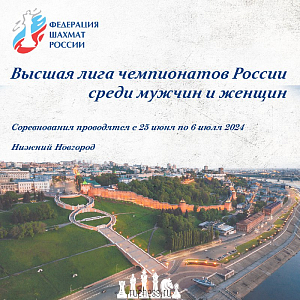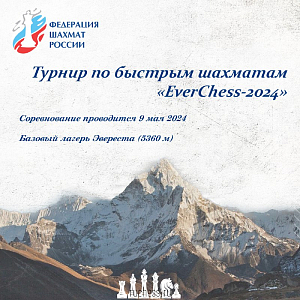14 September 2015
In the Spirit of Old Masters
Round Eight review of the Junior World Chess Championship prepared by IM Vladimir Barsky.
An excellent win has been scored by the young Russian grandmaster Mikhail Antipov, who sacrificed a pawn for the active piece play and then went on to transform this initiative into an irresistible attack.
Antipov – Van Foreest
1.e4 e5 2.Nf3 Nc6 3.Bc4 Nf6 4.d3 Bc5 5.0–0 0–0 6.c3 d5 7.exd5 Nxd5 8.b4 Be7 9.b5 Na5 10.Bxd5 Qxd5 11.c4 Qd7
The game has been opened by one of the lines of the Italian game that became popular recently. The idea of the last Black’s move is to keep the d8-square vacant for either the rook or the bishop. However, queen retreats to other squares are possible in this position as well, e.g.: 11...Qd8 12.Bd2 e4 13.Bxa5 exf3 14.Qxf3 a6 15.a4 axb5 16.axb5 Qd7 17.Bc3 Rxa1 18.Bxa1 Rd8 19.Qg3 f6 20.d4 with an edge for White, as in Jobava - Almasi, Bergamo 2014.

12.Nc3!?
This natural move turns out to be a novelty. The е5-pawn is, of course, untouchable in view of 12…Qd4, though all the previous games have seen only 12.Bd2 and 12…e4 as a response. For example, 13.Bxa5 exf3 14.Qxf3 a6 15.bxa6 (15.a4 axb5 16.axb5 Rd8 17.Rd1 Bb4) 15...Rxa6 16.Bc3 b5 with mutual counterchances, as in Yudin-Vallejo, Dubai 2014.
12...f6 13.Nd5 Bd8 14.Ba3 Re8 15.Rc1 a6
Although in the case of 15...c6 16.bxc6 bxc6 17.Nc3 Bb6 18.Qe2 Black succeeds in forcing the enemy’s knight out of the center, his own a5-knight still remains on the sideline.
16.b6!?
This is a display of a fearless type of play: in order to hold the d5-square for his knight White is prepared to part ways with his pawn.
16…cxb6
16...c6 17.Ne3 Bxb6 would be an alternative, although after 18.c5 Bc7 19.Qa4 the knight on а5 starts to feel rather uncomfortable.
17.Nd2 f5 18.f4

18…e4
Black features a lot of interesting possibilities in this critical opening position such as:
1) 18...exf4 19.Qf3 b5 20.Rce1;
2) 18...Nc6 19.fxe5 Nxe5 20.Qb3;
3) 18...b5 19.fxe5 bxc4 20.Bd6.
The first impression is that White gets sufficient compensation for the missing pawn in all lines, although the arising positions are of a very complex nature.
19.Re1 b5
19...exd3 20.Qh5 Re2 21.Rxe2 dxe2 22.Qxe2 Qf7 23.Nf3 Nc6 is worth paying attention to since Black markedly improved the position of his pieces.
20.dxe4 fxe4?
This is a decisive mistake. Black should by all means take care about the development of his queenside and play 20...Qf7, freeing the way to his c8-bishop. It might be followed up by 21.Ne3 (21.Qf3 Nxc4; 21.cxb5 axb5 22.Bd6) 21...fxe4 22.Nxe4 Bb6 23.Ng5 Rxe3 24.c5 Rxe1+ 25.Qxe1 Qg6 26.cxb6 Nc4 27.Qe7 Bf5 with mutual counterchances.
21.Nxe4 Nxc4 22.Qh5!
All White’s pieces have come to occupy the shooting positions.
22..Re6
If 22...g6, then 23.Qh6 Qg7 24.Nef6+.

23.f5 Qxd5
23...Re5 is decisively met by 24.Nd6 Rxe1+ 25.Rxe1 Nxd6 26.Bxd6. The knight sacrifice has to be accepted, although it turns out that it is far from being the last one!
24.Ng5! Bxg5 25.Qe8+! Rxe8 26.Rxe8+ Kf7 27.Rf8#. What a spectacular finish!
Bajarani – Duda

The game on the first table proceeded in quite a different manner. Black was gradually outplaying his opponent and reached the ending being up a pawn. Nevertheless, converting this advantage was extremely difficult in view of the restricted amount of material remaining on the board. However, at one moment of the game the Black’s winning chances started to take a real shape.
After 84...h4! 85.Rf4 Re5+ 86.Kd2 (86.Kf2 Re4) 86...Rd5 87.Ke3 Ne6 88.Rf1 Ng5 White would have been up against rather difficult tasks to resolve. Duda, however, made up his mind to play otherwise.
84…Kg5? 85.h4+!
The Azerbaijani grandmaster is known to not miss such rejoinders, let us at least remember his game against Karen Grigoryan. Now that the black king is forced to retreat the position becomes equal.
85…Kh6 86.Rd2 Re5+ 87.Kf2 Re4 88.Kg3 Kg6 89.Ra2 Re3+ 90.Kf2 Re6 91.Ra8 f4 92.Rg8+ Kf6 93.Bxh5 Rc6 Draw.
Shardul – Abasov

The opponents played out the Vienna variation of the Queen’s Gambit. Black just developed his bishop to f5, the move that was first employed by Vladimir Kramnik in 2010 in his game against Levon Aronian at the Tal Memorial in Moscow. Here the Indian player bravely took the d5-pawn, though it has been known for some five years that this pawn is poisoned.
18.Qxd5? Rfc8 19.Be2 Rc1+ 20.Bd1 Bc2 21.Ke2 Rc8 22.Be7
22.Re1 is met by 22…Rc5! as it is essential for Black to secure access to the c4-square for his queen. One of the possible lines runs as follows: 23.Qd8+ Kh7 24.Bxc2+ R5xc2+ 25.Kf1 Qc4+ 26.Kg1 Re2!, and Black is winning.
22...Bxd1+?
This is a miscalculation. Black should have immediately embarked into opening the second front on the kingside: 22...Qg4! 23.Rf1 Qxg2 (23...Be4!? is also good) 24.Qd7 Rc7 25.Qd8+ Kh7 26.Qd4, and now the simplest win is 26…Qxf1+ 27.Kxf1 Rxd1+ with a decisive material advantage.
23.Rxd1 R8c2+ 24.Nd2?
White returns the favor. Both 24.Rd2 and 24.Ke1 Rxd1+ 25.Qxd1 Qc4 26.Nd2 Qc3 27.Ke2 would result in a draw.

24...Qg4+! 25.Qf3 Qc4+ 26.Ke1 Qd3 27.Qe2 Qc3! White resigns.
In the women's tournament Zhansaya Abdumalik from Kazakhstan lost her first half-point: her game against fellow countryman Dinara Saduakassova saw an extremely intense but equal struggle and ended in a draw, whereas the Ukrainian Nataliya Buksa scored a full-point to shorten the gap between herself and the leader down to one point.
Buksa – Navrotescu

In this sharpest position with both kings being vulnerable Black committed a one-move blunder.
34…Bd6?? 35.Nc6+! Black resigns.
Bivol – Paredes

Alina Bivol is known to be just unstoppable once she is able to train her guns against her enemy’s king!
26.Bg5! Re8 27.Bf6+ Kg8 28.Bf1! Bxf6 29.Qxf6 Qf7 30.Bc4! Black resigns (30…Qxc4 31.Rd7).





















